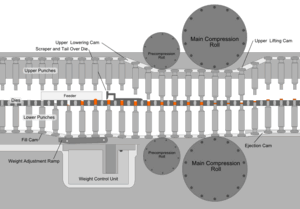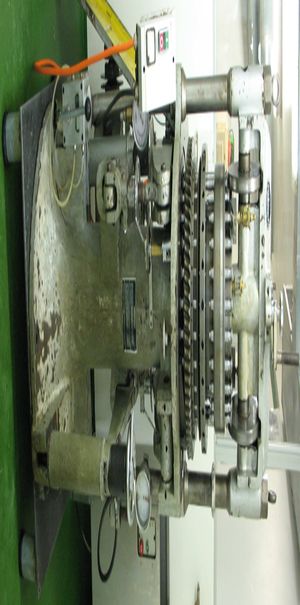Difference between revisions of "Tablet press"
m (→References: fixed typo) |
(Created page with "A tablet press in operation A '''tablet press''' is a mechanical device that compresses powder into [[tabl...") |
||
| Line 16: | Line 16: | ||
[[Category:Machines]] | [[Category:Machines]] | ||
| − | |||
| − | |||
| − | |||
| − | |||
Latest revision as of 17:20, 19 September 2010
A tablet press is a mechanical device that compresses powder into tablets of uniform size and weight. A press can be used to manufacture tablets of a wide variety of materials, including pharmaceuticals, illicit drugs such as MDMA, cleaning products, and cosmetics. To form a tablet, the granulated material must be metered into a cavity formed by two punches and a die, and then the punches must be pressed together with great force to fuse the material together.[1]
A tablet is formed by the combined pressing action of two punches and a die. In the first step of a typical operation, the bottom punch is lowered in the die creating a cavity into which the granulated feedstock is fed. The exact depth of the lower punch can be precisely controlled to meter the amount of powder that fills the cavity. The excess is scraped from the top of the die, and the lower punch is drawn down and temporarily covered to prevent spillage. Then, the upper punch is brought down into contact with the powder as the cover is removed. The force of compression is delivered by high pressure compression rolls which fuse the granulated material together into a hard tablet. After compression, the lower punch is raised to eject the tablet.[2]
Most high speed tablet presses take the form of a rotating turret that holds any number of punches. As they rotate around the turret, the punches come into contact with cams which control the punch's vertical position. Punches and dies are usually custom made for each application, and can be made in a wide variety of sizes, shapes, and can be customized with manufacturer codes and scoring lines to make tablets easier to break. Depending on tablet size, shape, material, and press configuration, a typical modern press can produce from 250,000 to over 1,000,000 tablets an hour. [3]
See also
References
Cite error: Invalid <references> tag;
parameter "group" is allowed only.
<references />, or <references group="..." />- Jump up ↑ Schwartz, Joseph; Lieberman, Herbert A.; Lachman, Leon (1989). Pharmaceutical dosage forms--tablets. New York: Dekker. ISBN 0-8247-8044-2.
- Jump up ↑ Isadore Kanfer; Shargel, Leon; Kanfer, Izadore (2005). Generic drug product development: solid oral dosage forms. New York, N.Y: Marcel Dekker. ISBN 0-8247-5460-3.
- Jump up ↑ Nash, Robert J.; Wachter, Alfred H; Berry, Ira R. (2003). Pharmaceutical process validation. New York, N.Y: Marcel Dekker. ISBN 0-8247-0838-5.

